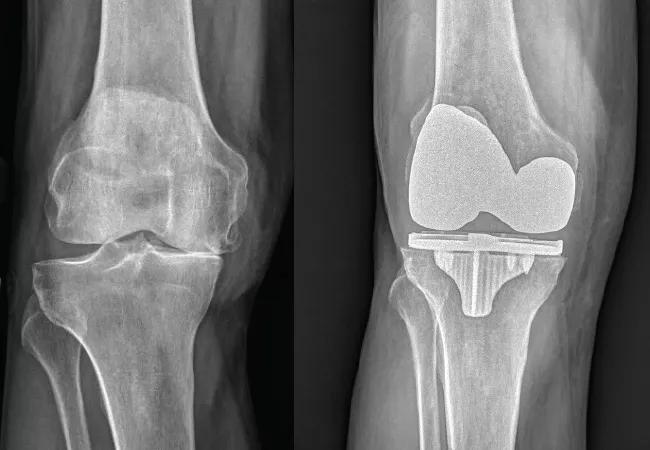The relationship between BMI and post-operative complications

The risk of developing major complications in the first 30 days following lower-extremity joint arthroplasty may be related to the severity of obesity, according to a new series of studies. The work suggests that, when it comes to evaluating surgical risks, it might be more accurate to consider body mass index (BMI) as a continuum rather than as a binary, with different weight categories correlated to different levels and types of post-operative complications. Understanding the interaction between BMI and complications is one way in which physicians are working to improve surgical outcomes.
Cleveland Clinic is a non-profit academic medical center. Advertising on our site helps support our mission. We do not endorse non-Cleveland Clinic products or services. Policy
Coauthors Carlos Higuera Rueda, MD, and Nicolas Piuzzi, MD, developed four retrospective cohort studies to assess obesity-related complications following total hip and knee joint replacement using dynamic statistical analyses. They reviewed data from the American College of Surgeons National Surgical Quality Improvement Program database, including the length of hospital stay and 30-day complications from each procedure.
In total knee arthroplasty, overweight patients had no higher overall complication risks than patients with BMIs in the normal range. However, obese patients had an increased risk of developing a pulmonary embolism, and morbidly obese patients had increased risks of readmission, reoperation, superficial infection, periprosthetic joint infection, wound dehiscence, pulmonary embolism, urinary tract infection, reintubation and renal insufficiency.
In unicompartmental knee arthroplasty, BMI does not appear to impact a patient’s risk of developing 30-day complications, with the exception of one: morbidly obese patients did have an increased risk of developing superficial surgical site infection.
In total hip arthroplasty, increased BMI was correlated to increased readmissions, reoperation, superficial infection, prosthetic joint infection and sepsis.
In terms of revision surgeries, there was a linear relationship between BMI and readmission and reoperation rates. Obese patients had a lower risk of organ/space surgical site infection compared to normal weight patients. Morbidly obese patients, however, had an increased risk of developing superficial SSI. For knee surgery, the lowest rate of complications occurred in patients with a BMI of approximately 30 kg/m2. For hips, the lowest rate occurred for patients with a BMI of 28 kg/m2.
“The studies revealed some key differences in how BMI affects complications based on joint replacement procedures,” Dr. Piuzzi says. “For example, the relationship between BMI and perioperative complications is stronger for revision TKA as opposed to revision THA.”
“The data showed that high-risk patients don’t necessarily have to reach a normal weight to improve surgical outcomes,” reveals Dr. Piuzzi. “These studies provide some potential goals for weight management that could ensure a safer procedure. For patients with very high BMIs, this offers a more realistic target to achieve to reduce their risk of complications.”
While risk optimization is very important, there is not always enough time to do so before surgery. “Most of the time, primary total knee and primary total hip replacements are elective surgeries that you can postpone, allowing time to optimize the patient before surgery,” notes Dr. Piuzzi. “However, sometimes revision surgeries have to be performed immediately due to infection or pain caused by a previous surgery.” The data revealed that revision surgeries involving total knee replacements carried a higher risk of complications as BMI went up, which was not always the case with total hip revision.
Patient education on weight management is key to improving surgical outcomes following total joint replacement. “Many patients are not aware of the strain that excessive weight puts on the joints,” says Dr. Higuera Rueda. “Patients must be helped to realize that obesity is a modifiable risk factor for elective surgery. Beyond surgery, losing weight can improve a patient’s life on so many levels, enhancing quality of life and maximizing life expectancy.”
“It also helps if surgeons look at patients holistically and understand the complexities involved in treating obese patients,” explains Dr. Piuzzi. “Then we can recommend strategies to modify obesity, including bariatric surgery and weight loss programs.”
The BMI/joint replacement studies help explain the overall relationship between BMI and joint replacement outcomes. To continue this research, Cleveland Clinic received a grant that will help fund the development of personalized methods to apply similar data analysis to individual patients. “By tailoring big data to individuals, we hope to better predict the outcome for these patients if they undergo surgery,” says Dr. Piuzzi. “We would like to be able to assign a value to the patient’s risk and then identify the appropriate BMI value needed to lower that risk.”
“Of course, our goal is to help patients to reduce risk factors. But, if high-risk patients do not succeed in losing weight, we need to be able to deliver proper surgical care,” notes Dr. Piuzzi. “We hope our research will also help establish some quality metrics and reimbursement plans that are tailored to each patient’s BMI and risk assessment.”
“Since high-risk patients require more resources and attention than patients with lower risks, we want to create special programs and strategies for taking care of these patients,” explains Dr. Higuera Rueda. “It all comes down to developing better approaches that lead to better care.”

Researchers hope it may one day help patients avoid explantation surgery

Patient age and baseline platelet count are considerable influences

Cleveland Clinic’s Adult Reconstruction Research leaders share what they’ve learned over 16 years

Cleveland Clinic researchers raise awareness of disparity and call for change

Patients who score lower than 40 on the VR-12 Mental Component Summary need more care after surgery

Reducing prescriptions may help keep unused medication out of the community

Optimize patients for surgery by reducing their overdose risk score

Study links worse presurgical pain, function and mental health with dissatisfaction one year after surgery